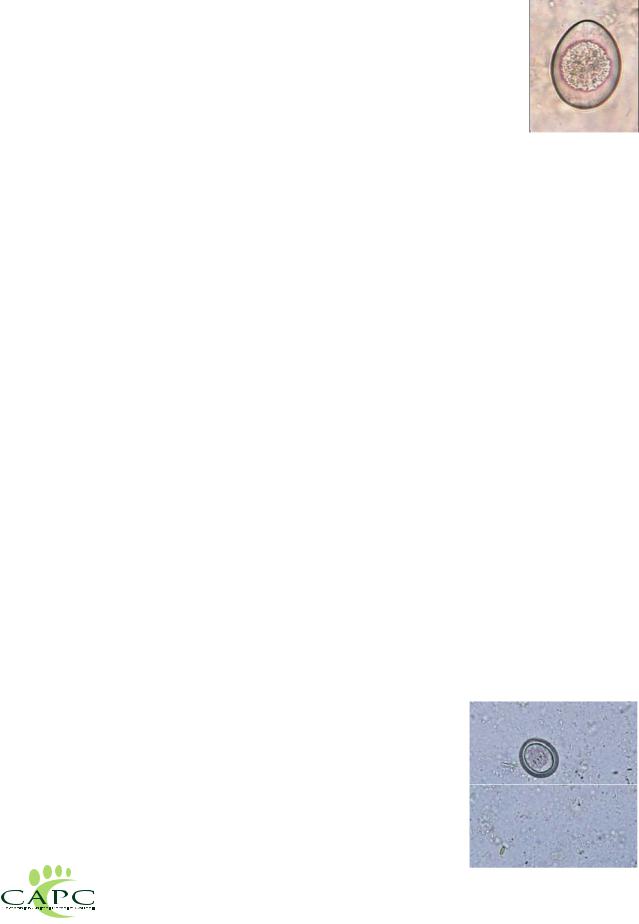
CAPC_National_Board_Review
.pdf
Parasitology Review Questions for the National Boards
provided by the Companion Animal Parasite Council
www.capcvet.org
1.To combat Texas cattle fever caused by Babesia bigemina, the vector tick, Boophilus annulatus, was eradicated from the United States through an ambitious program of intensive dipping of cattle. What aspect of the life cycle of this tick allowed the eradication program to be successful?
a.Boophilus annulatus is a one-host tick
b.Boophilus annulatus prefers to feed on animals other than cattle
c.Boophilus annulatus is a three-host tick
d.Boophilus annulatus has low tolerance for conditions of high humidity
e.Boophilus annulatus has a low tolerance for high temperatures
2.Which of the following animals would be most likely to serve as a source of Trichinella spp. infection to humans in the U.S.?
a.rabbit
b.sheep
c.cattle
d.bear
e.deer
3.This parasite ova was found on fecal flotation of a 5-year-old dog
with a history of intermittent bloody diarrhea. Which of the following is the most appropriate labeled pharmacotherapy?
a.pyrantel
b.ivermectin
c.metronidazole
d.trimethoprim-sulfa
e.fenbendazole
4.An egg (ova) of Pearsonema plica was detected on urine sediment examination of a 4-year- old neutered male mixed-breed dog with a history of cystitis. How did the dog become infected with this parasite?
a.skin penetration of third-stage larvae
b.ingestion of earthworm containing first-stage larvae
c.ingestion of egg containing third-stage larvae
d.migration of third-stage larvae up urethra to embed in urinary bladder mucosa
e.ingestion of dung beetle containing third-stage larvae
5.A 5-year-old gelding presents with ataxia and incoordination in all four limbs. A CSF tap reveals antibodies to Sarcocystis neurona. How did the horse most likely acquire this infection?
a.transmission of sporozoites via the bite of a tabanid fly
b.ingestion of oocysts from the feces of an infected horse
c.ingestion of sarcocysts in the muscle tissue of an infected opossum
d.transmission of sporozoites via tick bite
e.ingestion of sporocysts from opossum feces in contaminated feed or water

6.This parasite was detected on fecal flotation of a 3-month-old puppy with acute diarrhea. Although many dogs will self-cure this parasite, you decide to prescribe a treatment. What treatment is most appropriate?
a.sulfadimethoxine
b.fenbendazole
c.ivermectin
d.metronidazole
e.pyrantel
7.An adult budgie presents with severe crusting on the beak and cere which has resulted in severe deformity of the beak. What diagnostic assay is most likely to reveal the etiologic agent?
a.serum chemistry profile
b.bacterial culture of the crusted material for the presence of Staphylococcus
c.microscopic examination of the crusted material for mites
d.radiographs to evaluate calcium deposition in the long bones
e.virus isolation attempts on the crusted material
8.West Nile virus is commonly transmitted to horses, people, and other animals via:
a.fleas
b.mosquitoes
c.horse flies
d.ticks
e.biting midges
9.Which of the following groups of ectoparasites is not known to occur on pet birds?
a.sucking lice (Anoplura)
b.chewing lice (Mallophaga)
c.fleas (Siphonaptera)
d.mites (Acari)
e.all of these groups of parasites commonly occur on pet birds
10.An intact male feral kitten presents for routine examination. You notice large numbers of glistening white eggs adherent to the hair shafts on the dorsal and lateral aspect of the thorax. Closer inspection reveals several dorsoventrally flattened insects clinging to the hair shafts themselves. What parasite is this?
a.Phthirus
b.Linognathus
c.Hematopinus
d.Pediculus
e.Felicola
11.This egg was detected on flotation of feces from a 3-year-
old barn cat. How did the cat become infected with this parasite?
a.ingestion of infected flea
b.ingestion of infected rodent
c.ingestion of infected rabbit
d.transmitted via bite of infected flea
e.transmitted via bite of infected rodent
Page 2 of 19

12.A 5-month-old intact female barn kitten presents with a subcutaneous mass in her neck. Upon examination you notice an opening in the mass. This organism was removed with forceps. What parasite is this?
a.Oestrus
b.Hypoderma
c.Gasterophilus
d.Cuterebra
e.Cephenmyia
13.Which of the following are effective for the treatment of clinical coccidiosis in cattle?
a.amprolium
b.metronidazole
c.decoquinate
d.a and b
e.all three drugs listed
14.Pigs become infected with the thorny-headed worm, Macracanthorhynchus hirudinaceus, upon:
a.ingestion of free L3 from the environment
b.skin penetration by L3 from the environment
c.ingestion of L3 in larvated eggs from the environment
d.ingestion of an infected beetle containing a cystacanth stage
e.ingestion of L1 in the fresh feces of a fellow pig
15.Lice infestations on cattle are more common in the:
a.winter
b.spring
c.summer
d.fall
e.there is no seasonal pattern to louse infestation
16.Cats infected with Dirofilaria immitis:
a.routinely develop severe reactions to administration of monthly heartworm preventatives due to rapid death of microfilaria
b.are usually microfilaremic, allowing diagnosis via Knott or filter test or examination of a wet mount of whole blood
c.occasionally develop disease due to aberrant migration of the worms, including to the central nervous system or ocular tissues
d.often harbor large numbers (>50) of adult worms
e.have not been shown to develop any significant clinical disease due to infection
17.Which of the following drugs is effective for treating Giardia and has the least toxicity problems associated with its use in dogs and cats?
a.ivermectin
b.milbemycin
c.metronidazole
d.albendazole
e.fenbendazole
Page 3 of 19

18.Fecal flotation on a 4-year-old intact male cat reveals this parasite ova. What clinical disease is this parasite most commonly associated with?
a.cystitis
b.neurologic disease (circling, ataxia)
c.respiratory disease
d.vomiting
e.anemia
19.A rabbit with a severe ear infection caused by mites is brought to your clinic. The organism most likely responsible is
a.Psoroptes cuniculi
b.Otodectes cynotis
c.Knemidocoptes mutans
d.Sarcoptes scabiei
e.Polyplax serrata
20.Anthelmintic resistance has been widely documented to occur in small strongyles (= cyathostomes) of horses with which of the following dewormers?
a.pyrantel
b.fenbendazole
c.ivermectin
d.moxidectin
e.a and b
21.What arthropods are commonly known to transmit Anaplasma marginale between cattle in the United States?
a.Dermacentor ticks
b.Tabanus horse flies
c.biting midges (Culicoides)
d.mosquitoes
e.a and b
22.A dog presents with severe pruritus. Alopecia, erythematous skin, and hyperkeratosis are evident on the lateral elbows, lateral hocks, and the margins of the pinna. The dog scratches himself repeatedly during your examination, but otherwise appears healthy. What diagnostic test should you perform first?
a.skin scrape
b.fecal flotation
c.fecal sedimentation
d.urinalysis with sediment examination
e.complete blood count and serum chemistry panel
23.In recent years, several commercially-available equine dewormers have been modified to include praziquantel. What was responsible for this change?
a.new data demonstrating the clinical association between trematodes and colic
b.new data demonstrating the clinical association between tapeworms and colic
c.new data describing trematodes as a parasite of horses
d.new data describing tapeworms as a parasite of horses
e.recognition of widespread anthelmintic resistance in equine nematodes to the avermectin dewormers (ivermectin, moxidectin, etc…)
Page 4 of 19

24.A litter of 2-week-old kittens presents covered with a huge number of fleas. The kittens are hypothermic, have pale mucous membranes, and appear moribund. Which of the following would not be an appropriate means of managing these kittens:
a.apply high concentration spot on pyrethrin (45-65%) residual flea control product to each kitten
b.keep the kittens warm by placing on a circulating-water heating pad
c.check PCV and consider blood transfusion if indicated
d.immediately remove fleas via flea comb and gentle shampoo
e.administer supplemental iron and vitamin B12 to each kitten
25.A client brought in these nematodes after his 6-year-old
spayed female indoor/outdoor cat vomited them onto the kitchen floor this morning. How did the cat most likely become infected?
a.transplacental transmission from the queen as a kitten
b.transmammary transmission from the queen as a kitten
c.ingestion of an insect intermediate host or vertebrate paratenic host
d.ingestion of larvated egg from the enviroment
e.ingestion of the third-stage larvae from the vomit of another cat
26.Dogs acquire infection with Hepatozoon sp. upon:
a.tick bite
b.flea bite
c.ingestion of infected ticks
d.ingestion of infected fleas
e.none of the above
27.A cat is infested with mites that you identify as Dermanyssus species. You ask the client:
a.Whether or not the cat has access to birds
b.Whether or not the cat is a mouse hunter
c.Whether or not the cat spends a lot of time near rabbit dens
d.Whether or not the family dog has been pruritic
28.The term “measly beef” refers to the presence of:
a.eggs of Taenia saginata in muscle tissue
b.cysticerci of Taenia saginata in muscle tissue
c.sarcocysts (tissue cysts) of Sarcocystis in muscle tissue
d.tissue cysts of Toxoplasma gondii in muscle tissue
e.tissue cysts of Neospora caninum in muscle tissue
29.Neospora caninum infection in cattle causes:
a.weight loss
b.bloat
c.sterility in bulls
d.abortion
e.chorioretinitis in aged (> 10 years) animals
Page 5 of 19

30. Infection with which of the following parasites has been associated with head tilt and ataxia in rabbits?
a.Encephalitozoon cuniculi
b.Baylisascaris procyonis
c.Obeliscoides cuniculi
d.Passalurus ambiguous
e.a and b
31. A 2-year-old indoor/outdoor neutered male cat presents with lethargy, depression, and anorexia of two days duration. Physical examination reveals a profoundly icteric, moribund cat with pale mucous membranes and severe dehydration. These organisms were found on blood smear. As you explain your treatment plan and prognosis to the client, she asks if there is anything she can do to protect her four other cats at home from becoming infected. What do you recommend?
a.prevent ingestion of rodents and rabbits
b.flea control, including keeping cats indoors and on highly effective flea control products
c.tick control, including keeping cats indoors and on highly effective tick control products
d.prevent ingestion of birds
e.administer a monthly heartworm preventative with intestinal parasite control
32.Control of Potomac horse fever in unvaccinated horses includes:
a.administering prophylactic doses of praziquantel to control the vector flukes
b.routine application of insecticides to horses to prevent feeding by flies
c.administering prophylactic doses of penicillin antibiotics to control the Neorickettsia
(= Ehrlichia) risticii
d.avoiding aquatic habitats that may be more likely to harbor infected trematodes
e.protecting feed and water from possible contamination with opossum feces
33.A five-year-old horse presents with tail rubbing and anal pruritus. You suspect infection with the equine pinworm, Oxyuris equi. What diagnostic test is preferred to recover the eggs of this parasite?
a.direct smear
b.passive fecal flotation with sodium nitrate
c.centrifugal fecal flotation with sugar solution
d.fecal sedimentation
e.scotch tape test
34.Treatment of dogs with severe, generalized demodectic mange should always include:
a.antibiotics
b.anti-mite agents
c.anti-fungal agents
d.antibiotics and anti-mite agents
e.anti-fungal agents and anti-mite agents
Page 6 of 19

35.A litter of 2-week-old puppies presents with acute lethargy. On physical examination the puppies are moribund, cold, and have markedly pale mucous membranes. You suspect acute anemia due to hookworm infection. The next step in managing these puppies is:
a.prophylactically deworm with pyrantel pamoate
b.perform a fecal flotation and only deworm if eggs are detected
c.perform CBC, serum chemsitry, U/A, and abdominal radiographs on each pup
d.hold for quiet observation for 48 hours to monitor progression of disease
e.bathe each puppy to insure ectoparasites are eliminated
36.These eggs were found on fecal flotation from a 10-year-old
spayed female indoor/outdoor cat. Is this an unusual diagnosis?
a.no, this parasite is commonly seen in both kittens and adult cats
b.yes, this parasite is extremely rare in cats in the United States
c.yes, this cat is likely immunocompromised and thus the immunity that would prevent the infection has lapsed
d.yes, this parasite is generally only found in kittens
e.no, this parasite is commonly seen in the feces of coprophagic cats that ingest the eggs in the feces of another animal
37.What aspect of the life cycle of Habronema and Draschia spp. accounts for the seasonal pattern seen in cutaneous habronemiasis, or summer sores, in affected horses?
a.the bacterial organisms which cause the secondary infections responsible for the lesions only flourish in the humid summer months
b.the larval stages of these nematodes become hypobiotic in the winter and are thus less irritating to horses
c.the ticks which transmit these parasites are only active in the summer months
d.the activity of the muscid flies which serve as vector and intermediate host of these nematodes is greatly reduced in the winter months
e.horses are ridden less in the winter months and thus the abrasive sores are less likely to develop
38.You examine an adult Himalayan cat who has just returned from Panama with his owner. The cat has a persistent, draining wound on the right lateral flank. You sedate the cat to clip the hair and examine the wound and discover several fly larvae, each ~ 1 cm long and bearing two distinct pigmented tracheal trunks. What parasite is this?
a.Calliphora vomitoria
b.Haematobia irritans
c.Felicola subrostratus
d.Sarcophaga carnaria
e.Cochliomyia hominovorax
39.Which of the following antiparasitic agents is most suitable for use against immature stages of Fasciola hepatica?
a.fenbendazole
b.ivermectin
c.praziquantel
d.albendazole
e.clorsulon
Page 7 of 19

40.A 4-year-old neutered male outdoor cat from Florida presents with a 2-week history of weight loss, vomiting, and diarrhea. This parasite was produced in the vomitus. What is the most appropriate treatment?
a.ivermectin
b.fenbendazole
c.selamectin
d.praziquantel
e.milbemycin oxime
41.An 8-year-old mixed breed mare presents with head shaking and aural irritation due to the presence of several heavily-spined nymphal soft ticks in both ears. What parasite is this?
a.Ixodes
b.Dermacentor
c.Otobius
d.Amblyomma
e.Rhipicephalus
42.The short prepatent period of this nematode insures that eggs of this parasite are likely to be the first detected in a fecal float on a young foal:
a.Oxyuris equi
b.Strongylus vulgaris
c.Parascaris equorum
d.Strongyloides westeri
e.Drashia megastoma
43.A mixed breed dog that is housed outdoors on soil in a run presents with lesions on its ventral and dorsal surfaces of all four feet, sternum, and ventral abdomen. The areas are erythematous, thickened, and alopecic. The owner informs you that ever since the dog was adopted two years ago from a neighbor, the dog has only had yearly routine vaccinations (rabies, DA2PP). The organism responsible for these lesions is most likely:
a.Aelurostrongylus abstrusus
b.Ancylostoma tubaeforme
c.Protostrongylus rufescens
d.Ancylostoma caninum
e.Bunostomum phlebotomum
44.A client has just returned from a winter vacation to Greece where she adopted a stray dog. She is concerned about the multiple patches of alopecia on the dog’s face and pinnae; you also note that the nasal planum is depigmented. With leishmaniasis as your top differential diagnosis, which statement is the least accurate?
a.The organism is found intracellularly in erythrocytes.
b.It is unknown exactly how infection is spread from dog to dog within North America.
c.This disease is only very rarely reported in cats.
d.Horses can also suffer from the cutaneous form.
e.The incubation period can be as long as several years.
Page 8 of 19

45.These organisms were found in the aural exudate from a 12-week-old kitten with a 3-day history of external otitis and aural pruritus. Of the choices listed, what is the most appropriate therapy?
a.an organophosphate/carbamate (e.g. fenthion, carbaryl)
b.a benzimidazole (e.g. fenbendazole)
c.an avermectin/milbemycin (e.g. ivermectin, milbemycin oxime, selamectin)
d.amoxicillin
e.doxycycline
46.A 5-year-old intact male cat present with choleostasis and liver failure. Fecal sedimentation reveals an operculated egg with a fully-formed miracidium. The most likely diagnosis is:
a.Fasciola hepatica
b.Platynosomum fastosum
c.Taenia taeniaeformis
d.Spirometra mansonoides
e.Dipylidium caninum
47.This parasite is unusual among the trichostrongyles in that it not only infects ruminants, but also infects many other host species including horses and pigs. It is one of the few parasites of potential concern in a mixed-species grazing situation.
a.Cooperia punctata
b.Trichostrongylus axei
c.Haemonchus contortus
d.Nematodirus battus
e.Ostertagia ostertagi
48.Foals become infected with Parascaris equorum:
a.when they ingest larvated eggs from a contaminated environment
b.transplacentally (in utero) from the somatic tissue stores in the mare
c.transmammarily (via milk) from larvae mobilized from mare somatic tissue
d.by inadvertent ingestion of insect intermediate hosts when grazing
e.by inadvertent ingestion of avian tissues in contaminated feed
49.The main significance of Acanthocheilonema (=Dipetalonema) reconditum in veterinary medicine is:
a.severe disease caused by death of microfilaria following treatment for Dirofilaria immitis
b.pathology seen in infected fleas and future potential for biological flea control
c.severe pathology caused by migration of this subcutaneous worm
d.microfilaria are similar in appearance to those of Dirofilaria immitis and thus may confound diagnosis
e.severe disease caused by death of subcutaneous adult nematodes following treatment for Dirofilaria immitis
Page 9 of 19

50.Routine fecal flotation from a 4-year-old cat with no history of clinical disease revealed this parasite egg. Adults of this parasite are most likely to be found in the:
a.esophagus
b.nasal, tracheal, and bronchial mucosa
c.large intestine
d.stomach
e.lung parenchyma
51.Although now rarely seen in managed horses, the migrating larvae of this large strongyle can cause severe inflammation in the wall of the cranial mesenteric artery, and this nematode was, at one time, the most commonly diagnosed cause of equine colic:
a.Strongylus minor
b.Strongylus edentatus
c.Strongylus equinus
d.Strongylus cyathostomus
e.Strongylus vulgaris
52.You perform rectal palpation on a 2-year-old standardbred horse with a history of acute diarrhea and colic. When you withdraw your arm you notice several bright red larval worms wriggling around on the palpation sleeve. What equine nematodes are most likely responsible?
a.ascarids (Parascaris equorum)
b.large strongyles (Strongylus spp)
c.small strongyles (cyathostomes)
d.pinworms (Oxyuris equi)
e.threadworms (Strongyloides westeri)
53.A 5-month-old spaniel puppy vomits a mass of thick stout white nematodes. On close inspection, you note the presence of three lips at the anterior end of each of the worms. What parasite is this most likely to be?
a.Toxocara canis
b.Toxocara cati
c.Toxascaris leonina
d.Ancylostoma caninum
e.Trichuris vulpis
54.Which of the following nematodes is free-living by nature, but occasionally causes opportunistic infections associated with dermatitis in animals?
a.Rhabditis
b.Physaloptera
c.Gongylonema
d.Toxascaris
e.Dioctophyme
55.A dog that chases and eats wild rabbits is most likely to become infected with which cestode?
a.Echinococcus granulosus
b.Taenia saginata
c.Diphyllobothrium latum
d.Dipylidium caninum
e.Taenia pisiformis
Page 10 of 19
